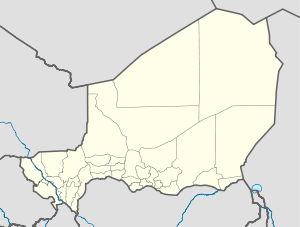Maradi, Niger
| Maradi | |
|---|---|

A street in Maradi
|
|
| Location in Niger | |
| Coordinates: 13°29′30″N 7°5′47″E / 13.49167°N 7.09639°E | |
| Country |
|
| Region | Maradi Region |
| Department | Maradi Department |
| Urban Commune | Maradi |
| Government | |
| • Type | Seat of Departmental and Regional councils, Urban Commune |
| Elevation | 385 m (1,259 ft) |
| Population (2012) | |
| • Total | 206,414 |
Maradi is the third largest city in Niger and the administrative centre of Maradi Region. It is seat of the Maradi Department and an Urban Commune.
Originally part of Katsina, a Hausa state, it became independent in the 19th century. From the early 19th century, Maradi was home to one of several Hausa traditional rump states, formed by rulers and nobility who fled the rise of the Sokoto Caliphate. Elements of the Katsina ruling class continued to claim the area as the seat of a Katsina exile state ruled by the Sarkin Katsina Maradi. Maradi was constrained by the more powerful Gobir exile state to the west, the Sultanate of Damagaram based at Zinder to the east, and Sokoto to the south. The arrival of the French in 1899 saw first the bloody destruction of the town by the Voulet-Chanoine Mission, but later saw the town recover as an important regional centre of commerce by the 1950s. The expansion of the city in the first half of the 20th century was dynamic, albeit modest, with the population nearly doubling between 1911 and 1950. Up until 1945, the ancient city of Maradi was located in the valley bordering the Goulbin Maradi, a seasonal waterway with source in Nigeria. The agglomeration, roughly circular in shape, was protected by a mud wall with four doors. The ancient city was flooded by Goulbin at the end of the rainy season of 1945. To avoid future inundation, the colonial administration decided then to adjust the urban layout. In the process, the city lost its traditional, irregular layout in favour of a grid-iron street layout system. The colonial administration sought to create an exploitative cash-crop agriculture, mostly groundnuts, which increasingly made the city an important regional commercial centre. Aided by the economic growth after the 1950s, the city of Maradi experienced a demographic boom, with the population increasing from 8,661 in 1950 to 80,000 by 1983. By the time of Niger's independence in 1960, Maradi was a centre of Hausa culture, vying with the larger traditional Hausa centre of Zinder to the east.
The city is divided into three urban municipalities: Maradi I, Maradi II and Maradi III.
...
Wikipedia

